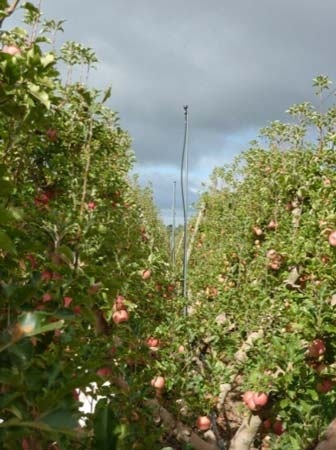Evaporative cooling
When heatwaves have occurred in SE Australia during the past five years, over-head sprinklers used in a small number of orchards have commonly been observed to contribute to reduced heat damage to fruit.
Evaporative cooling systems can lower apple surface temperatures in orchards by 10C or more depending on conditions (Figure 2).
In some overseas studies, this type of cooling has reduced sunburn by 25 to 45% (Parchomchuk & Meheriuk 1996; Gindaba & Wand 2005).
Rates of evaporation depend on radiation, wind-speed, temperature and humidity. Evaporative cooling is most effective in low humidity, windy situations but it is only effective when applied at the time of sunburn risk, which is usually the hottest part of the day.
Pulsed application
Cooling systems should operate to maximise evaporative efficiency while minimising the amount of water applied—and pulsed application typically achieves this.
Cycle ratios or feedback systems are set so that free water is almost continually present to evaporate from the fruit surface—evaporative cooling only works when water is present on fruit.
Once the fruit surface is dry, evaporation is no longer a source of cooling and surface temperature can rapidly increase.
Some pulsed cooling systems operate on the basis of time schedules (e.g. 20 min on, 20 min off) while others use air, fruit or simulated fruit temperatures as triggers to apply water.
The most effective cooling strategies are based on actual exposed fruit temperatures. Applications rates in the range of 2.3 to 4.5 mm/hour have worked overseas. However, while evaporative cooling is an effective way of decreasing apple fruit surface temperature, evaporative cooling does not filter out damaging ultraviolet-B rays.
Other effects
Other impacts of over-tree cooling on fruit quality depend on a number of factors.
In general, blush, firmness, weight and soluble solids concentrations tend to remain the same or show a slight increase.
Potential drawbacks associated with over-tree evaporative cooling systems include:
capital expense of hardware
water availability and price
increased disease risk
fungicides, foliar nutrient applications and herbicides applied to weeds can be washed off.
See this article in Tree Fruit April 2015




















